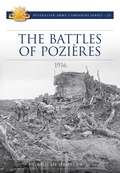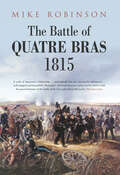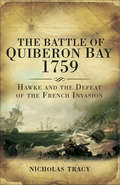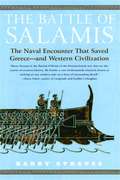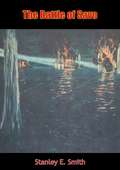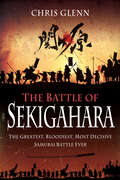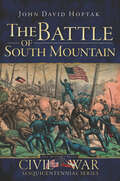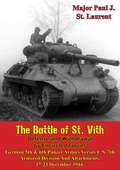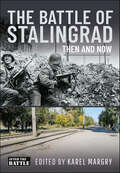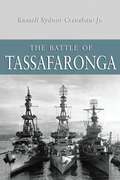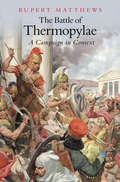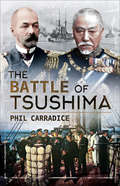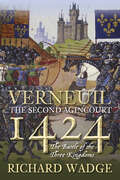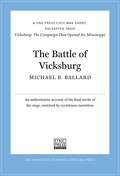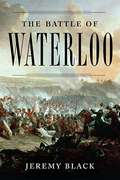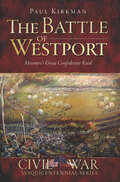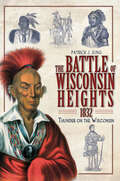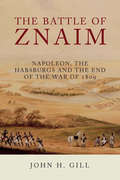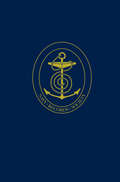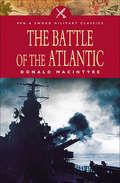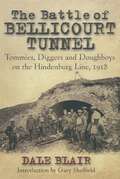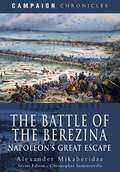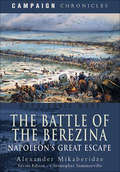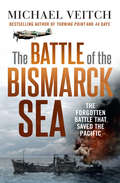- Table View
- List View
The Battle of Pozieres 1916 (Australian Army Campaigns #22)
by Meleah HamptonThe Battle of Pozières has reverberated throughout Australia’s military history, long regarded as a costly battle that produced little meaningful gain. Pozières was characterised by the most intense artillery bombardment the Australians had experienced in the war thus far and ‘the hell that was Pozières’ became the yardstick by which subsequent bombardments were measured. The 13th Battalion’s Frank Massey described men who became ‘blithering idiots … Crying and weeping and — absolutely useless as a fighting man.’ The object of the battle was Pozières Ridge, a low rise that offered a good view of the German positions. Heavily fortified, the ridge and the pulverised remains of the village were contested bitterly and, during its six-week campaign, 1st Anzac Corps advanced little more than two miles and suffered 23,000 casualties. Charles Bean wrote that ‘Australian troops … fell more thickly on this ridge than on any other battlefield of the war.’ However, the first phase of the campaign was very successful, securing the fortified ruins of Pozières and the German second line. But follow-up operations failed to capitalise and subsequent assaults merely nibbled away at enemy positions without making significant headway. Yet the Battle of Pozières marks a significant achievement not only for 1st Anzac Corps, but for the British Expeditionary Force. In a war in which any advance was hard won, the wresting of the high ground from the Germans was crucial. For the battered Allied forces, the capture of Pozières Ridge provided faint hope of an end to a catastrophic war.
The Battle of Quatre Bras 1815
by Mike RobinsonMajor Richard Llewellyn, who fought at Quatre Bras, wrote in 1837 that, 'Had it not been so closely followed by the... victory of Waterloo, perhaps the gallant exploits and unexampled bravery that marked that day would... have excited even more admiration than was actually associated with it.'This book stands out from the wealth of Napoleonic literature in that it is the first English-language account to focus solely on the battle of Quatre Bras. It is based upon extensive research and in many cases unpublished personal accounts from all participating countries, as well as a detailed topographic, aerial survey of the battlefield. These combine to provide a highly personal, balanced and authoritative work. The author unravels the controversies of a battle where commanders made errors of omission and commission and where cowardice rubbed shoulders with heroism. This is the story of a battle that turned a campaign; of triumph and disaster. It is a story of two great generals, but more importantly, of the intense human experience of those that they led. It is a book that will appeal to both the scholar and the generalist.
The Battle of Quiberon Bay, 1759: Hawke and the Defeat of the French Invasion
by Nicholas TracyRevered naval theorist, Alfred Thayer Mahan, thought the Battle of Quiberon Bay (20 Nov 1759) was as significant as Nelson's victory in 1805, calling it 'the Trafalgar of this war [the Seven Years War]'. Arguably it was even more vital. Britain in 1759 was much less well-defended, with virtually no regular troops at home, and the threat of French invasion was both more realistic and more imminent. When the British fleet under Admiral Hawke fell upon them, the French ships of the line under Admiral Conflans were actually on their way to rendezvous with the invasion troopships gathered at the mouth of the Loire. Yet the battle and the admiral remain relatively obscure—there is no Quiberon Square or Hawke's column. The battle itself was fought in terrible weather, the French attempting to exploit their local knowledge by heading for Quiberon Bay, assuming the British would not follow them among its treacherous shoals in such conditions. Hawke, however, pursued them under full sail and the French ships were destroyed, captured, run aground or scattered for the loss of only two British ships which ran aground. The invasion was thwarted. Professor Nicholas Tracy studies the battle and its strategic consequences, particularly upon the war for North America.
The Battle of Salamis: The Naval Encounter That Saved Greece and Western Civilization
by Barry StraussOn a late September day in 480 B.C., Greek warships faced an invading Persian armada in the narrow Salamis Straits in the most important naval battle of the ancient world. Overwhelmingly outnumbered by the enemy, the Greeks triumphed through a combination of strategy and deception. More than two millennia after it occurred, the clash between the Greeks and Persians at Salamis remains one of the most tactically brilliant battles ever fought. The Greek victory changed the course of western history -- halting the advance of the Persian Empire and setting the stage for the Golden Age of Athens. In this dramatic new narrative account, historian and classicist Barry Strauss brings this landmark battle to life. He introduces us to the unforgettable characters whose decisions altered history: Themistocles, Athens' great leader (and admiral of its fleet), who devised the ingenious strategy that effectively destroyed the Persian navy in one day; Xerxes, the Persian king who fought bravely but who ultimately did not understand the sea; Aeschylus, the playwright who served in the battle and later wrote about it; and Artemisia, the only woman commander known from antiquity, who turned defeat into personal triumph. Filled with the sights, sounds, and scent of battle, The Battle of Salamis is a stirring work of history.
The Battle of Savo
by Stanley E. SmithNight of Confusion…Down the “Slot”—that fabled channel between chains of islands in the Solomon group—steamed the task force of Admiral Gunichi Mikawa, Japanese Imperial Navy.His target: the Allied cruiser group gathered off Savo Island, near Guadalcanal.Three thousand Japanese guns were pointed at the destroyer Blue, on interception duty at the head of the Allied column. But no one aboard Blue noticed the enemy force churning past—so Blue roused no enemy fire.Not so lucky were the cruisers Quincy, Vincennes, Canberra and Astoria. This exciting factual book details the incredible confusion and horror that made the Battle of Savo a low point in American naval history.An American Naval TragedySo shocking was the defeat of American naval forces by the Japanese in Savo Sound, that the American public could not accept the true story until ten years afterward.On Guadalcanal, Marines were moving up the rugged Tenaru River country, ranging for battle and depending on the Navy for cover.On board the flagship McCawley, Admiral Turner was begging for carrier-based air support that never came.On the flag bridge of his heavy cruiser, Chokai, Admiral Gunichi Mikawa signalled the torpedo fire that opened “The Battle of Savo”.
The Battle of Sekigahara: The Greatest, Bloodiest, Most Decisive Samurai Battle Ever
by Chris GlennSekigahara was the greatest samurai battle in history. Japan had long been at civil war until brought under the rule of Oda Nobunaga, and then, following his death at the hands of a traitorous general, that of Toyotomi Hideyoshi. It was Hideyoshi who completed the unification of Japan and ushered in a period of peace. After Hideyoshi’s death in 1598, a power struggle emerged between those loyal to the Toyotomi, and those who supported the second most powerful warlord, Tokugawa Ieyasu. With Hideyoshi gone, Ieyasu made moves that brought the ire of a number of his contemporaries, and soon the entire country was divided into two great armies, East and West. Leading the loyalist cause was Ishida Mitsunari, who gathered a force of around 130,000 samurai, while the Tokugawa commanded just 80,000. Both sides hurried to seize strategically vital highways and castles. These attacks and sieges culminated in the decisive Battle of Sekigahara. Fought on 21 October 1600, the battle lasted just six hours, but saw the deaths of an estimated 30,000 samurai, the destruction of a number of noble families and the creation of the Tokugawa Shogunate that was to rule Japan for 260 years of relative peace. The loyalist forces, despite their superior numbers and excellent battle formations, were defeated. In his exploration of the battle, Chris Glenn reveals the developments that led up to the outbreak of war, the characters involved, how the battle itself unfolded, and the aftermath. The weapons and armor of the time are also fully explained, along with little known customs of the samurai and their warfare.
The Battle of South Mountain (Civil War Series)
by John David Koptak&“A thorough account of the fighting . . . Not only appealingly written but a worthwhile addition to Maryland Campaign literature.&” —Historynet.com In September 1862, Robert E. Lee led the Army of Northern Virginia north of the Potomac River for the time as part of his Northern invasion, seeking a quick end to the war. Lee divided his army in three, sending General James Longstreet north to Hagerstown and Stonewall Jackson south to Harper&’s Ferry. It was at three mountain passes, referred to as South Mountain, that Lee&’s army met the Federal forces commanded by General George B. McClellan on September 14. In a fierce day-long battle spread out across miles of rugged, mountainous terrain, McClellan defeated Lee but the Confederates did tie up the Federals long enough to allow Jackson&’s conquest of Harper&’s Ferry. Join historian John Hoptak as he narrates the critical Battle of South Mountain, long overshadowed by the Battle of Antietam. &“A remarkable work . . . The marches of both armies to South Mountain are presented with close attention to the men in the ranks. The combat is fully covered at each of the gaps in South Mountain.&” —Civil War Librarian &“A crisp, concise but comprehensive account of the battles at the four passes or &‘gaps&’ across South Mountain on September 14, 1862 . . . A truly scholarly effort that will satisfy both serious Civil War students and the general reading public. For Maryland Campaign aficionados, it is a must have addition to your library and is now the definitive account of the battle.&” —South from the North Woods
The Battle of St. Vith, Defense and Withdrawal by Encircled Forces: German 5th & 6th Panzer Armies Versus U.S. 7th Armored Division and Attachments, 17-23 December 1944
by Major Paul J. St. LaurentWhen the German Ardennes Offensive of December 1944 ruptured the front of the U.S. First Army, Major General Troy Middleton committed his VIII Corps to the defense of selected transportation bottlenecks in the path of the German advance. St. Vith, located in the central sector of the Ardennes battleground, was one of these. Although by passed by German spearheads bound for the Meuse River, the 7th Armored Division (plus major elements of three other divisions) held the position against major elements of two German Panzer armies. After six days of tenacious defense while practically encircled, the St. Vith force was ordered to withdraw. The defenders of St. Vith prevented the Germans from effectively supplying their armored spearheads, drew off their follow-on forces, and bought time for the U.S. First Army to consolidate its position on the north flank of the German penetration.
The Battle of Stalingrad: Then and Now
by Karel Margry"The combination of past and contemporary pictures regarding battle locations is of a great service for those of us with a passion for history." — Globe at War Stalingrad was not only the most-crucial battle on the Eastern Front, it was the main turning point of the whole Second World War in Europe. The Third Reich had suffered setbacks earlier, notably at El Alamein in North Africa in October 1942, but the scale of the fighting on the Eastern Front was incomparably larger than any of the other war fronts and it was the fate of the armies there that decided the outcome of the global conflict. After the demise of the German 6. Armee at Stalingrad in February 1943 it was clear that Nazi Germany would lose the war. This book brings together three After the Battle stories devoted to that historic struggle. It opens with a detailed account of the fight for the city of Voronezh. Lying on the great Don river, it was a prime initial objective of the German summer offensive towards the Caucasus launched on June 28, 1942. Possession of Voronezh would secure an eastern anchor point for a northern defensive line needed for the southward advance to Stalingrad. The city was taken with relative ease in early July but, when the Soviets launched a counter-offensive, the Heeresgruppe Süd commander, Generalfeldmarschall Fedor von Bock, allowed his panzer and motorised divisions to be drawn into the protracted fight. This week-long delay – which infuriated Hitler – severely disrupted the timetable for the main offensive, and fatally contributed to the failure to seize Stalingrad in a surprise raid. The main part of the book is taken up by a comprehensive description of the gargantuan seven-month battle for Stalingrad itself. All stages are described in detail: the advance of the German armies to the city in August, the stubborn and heroic defense of the besieged Soviet 62nd Army against overwhelming German superiority in September-November; and the subsequent encirclement and annihilation of the doomed 6. Armee in the winter, ending in total capitulation on February 2, 1943. Due to the wholesale destruction of the embattled city, it was long thought impossible to apply After the Battle’s ‘then and now’ format to Stalingrad but with the help of a local expert and acknowledged student of the battle, Alexander Trofimov, we managed to match up numerous combat photos taken all over the city, giving full treatment to the months-long struggle for the city on the Volga. The same goes for Voronezh where we found another local expert, Sergey Popov, who achieved equally astounding comparisons. Without them, this book could not have been made. The German catastrophe at Stalingrad, with around 150,000 men killed or succumbing to the winter cold and around 100,000 taken prisoner (of whom only some 5,000 survived captivity), remained a national trauma in Germany. Coming to terms with the event proved difficult, the sorrow over the loss of so many German lives being surmounted by guilt over the fact that Germany had been the aggressor. In many ways, Stalingrad became a taboo, remembered in silence but avoided in public discussion. Illustrative of this is the fact that it took a full 50 years before a major feature film on Stalingrad could be produced in Germany. It was only in 1992 that the German film industry felt the time was ripe and produced and released Stalingrad, the first full-fledged war movie on the battle. We include the story of the making of this film as an epilogue to the main story.
The Battle of Tassafaronga
by Russell Crenshaw Jr.The Battle of Tassafaronga, November 30, 1942, was the fifth and last major night surface action fought off Savo Island during World War II s Guadalcanal campaign. It ended a string of Japanese victories, but it was also a horrible embarrassment to the U.S. Navy, which had three heavy cruisers damaged and one sunk to enemy torpedoes. After the battle, American commanders erroneously reported that multiple enemy ships had been sunk or seriously damaged, leading Admiral Nimitz to focus on training as the missing ingredient. Not until more than half a century later did Captain Russell S. Crenshaw, Jr., the destroyer Maury s gunnery officer during the battle, discover that the outcome hinged instead on critical shortcomings that had been built into the U.S. Navy before the war defective torpedoes, poor intelligence, blinding gunfire, over-confidence, and a tendency to equate volume of fire with effectiveness of fire factors that turned the battle into a crucible in which the very nature of the U.S. Navy and its weapons was tested [and] a miniature of what might have been, under other circumstances, a truly devastating defeat.
The Battle of The Nile: A Ladybird Expert Book (The Ladybird Expert Series #35)
by Sam WillisPart of the ALL-NEW LADYBIRD EXPERT SERIES- Why was the Battle of the Nile so decisive in the French Revolutionary Wars?- Why did the French believe they were unassailable?- And why did Nelson and the British win?TRACK the revolutionary roots and dramatic turning points of the British Royal Navy's glorious victory over the French naval expedition to Egypt. From Napoleon's rise to prominence to Nelson's celebrated tactical leadership, discover how this significant battle changed the face of the French Revolutionary Wars.THE BATTLE THAT CHANGED THE BALANCE OF POWER IN EUROPEWritten by historian, archaeologist, and broadcaster Sam Willis, Nelson: Battle of the Nile is a thrilling and accessible account of the naval battle that established Nelson's fame.
The Battle of Thermopylae: A Campaign in Context
by Rupert Matthews‘Tell the Spartans, stranger passing by, that here obedient to their laws we lie.’ One of the most remarkable actions in ancient or modern military history took place at Thermopylae in 480BC. Rupert Matthews has personally examined the battlefield in order to try to explain how 300 Spartans could hold at bay the hordes of the Persian Emperor Xerxes. This was no vain sacrifice; the delay gave breathing space for the Greek states to organise their defence, and ultimately defend successfully their homelands. Among other intriguing revelations the author explains the importance of the half-ruined wall that sheltered the Spartans against the onslaught. With concise diagrams and maps of the entire campaign, the reader can begin to understand the extraordinary, apparently impossible outcome of the war.
The Battle of Tsushima
by Phil CarradiceThe author of The First World War in the Air details the gripping 1905 naval battle during the Russo-Japanese War.In 1905 Japan and Russia were at war. With the Russian Far East Fleet destroyed, the Czar sent his Baltic Fleet halfway around the world to exact revenge. This mammoth journey took many months and was an amazing feat of seamanship. But, at the end of this adventure, the Russians were totally overwhelmed, and the majority of the fleet was underwater. There was no alternative for the Czar but to sue for an ignominious peace.The story of the journey and the final battle remain fascinating, the people involved behaving like characters from a novel. Russian Admiral Rozhestvensky was a gunnery expert but had never held active command in a major sea battle. Japanese Admiral Togo had trained in Britain, enlisting as a cadet on the Training Ship Worcester, even though he was far too old and was forced to lie about his age. Inept generalship on the part of the Russians, combined with brilliant seamanship from Togo, saw the complete destruction of the Russian fleet.The naval battle of Tsushima is one of the forgotten actions of the twentieth century, but it has a significance that is immense in world history.“An utterly compelling story, well told by Carradice. We really sympathize with the Russian sailors, trapped on their ironclad warships for months as they battled against the elements, a largely hostile world, and even each other. The result is an excellent book that reminds us of the human cost of these massive naval battles.” —History of War
The Battle of Verneuil 1424: A Second Agincourt
by Richard WadgeIn August 1424 the armies of England, Scotland and France met in the open fields outside the walls of Verneuil in a battle that would decide the future of the English conquests in France. The hero king, Henry V, had been dead for two years and the French felt that this was their chance to avenge their startling defeat at Agincourt, and recover the lands that Henry had won for England. Despite its importance, the battle is largely overlooked in accounts of the Hundred Years War. The Battle of Verneuil 1424 is the first proper account of the battle, and is also one of the first books to outline the important part the Scots played in the wars in France in the years between the two great battles of Agincourt and Verneuil.
The Battle of Vicksburg
by Michael B. BallardThe Vicksburg campaign was among the longest of the Civil War, lasting from 26 May 1862 to 4 July 1863. This Civil War Short provides a compelling narrative of the final six weeks of the campaign, excerpted from Michael Ballard's Vicksburg: The Campaign That Opened the Mississippi, which blends strategy and tactics with the human element, reminding us that while Gettysburg has become the focal point of the history and memory of the Civil War, the outcome at Vicksburg was met with as much celebration and relief in the North as the Gettysburg victory, and it should be viewed as equally important today.UNC Press Civil War Shorts excerpt rousing narratives from distinguished books published by the University of North Carolina Press on the military, political, social, and cultural history of the Civil War era. Produced exclusively in ebook format, they focus on pivotal moments and figures and are intended to provide a concise introduction, stir the imagination, and encourage further exploration of the topic. For in-depth analysis, contextualization, and perspective, we invite readers to consider the original publications from which these works are drawn.
The Battle of Waterloo
by Jeremy BlackThe name Waterloo has become synonymous with final, crushing defeat. Now thislegendary battle is re-created in a groundbreaking book by an eminent Britishmilitary historian making his major American debut.
The Battle of Westport: Missouri's Great Confederate Raid (Civil War Sesquicentennial Series)
by Paul KirkamnThe story of the largest Civil War battle west of the Mississippi, in what would one day become Kansas City, and the role it played in American history. The Battle of Westport, Missouri—today part of Kansas City—was fought by troops from as far away as New Jersey and Pennsylvania, as well as Texas, Arkansas, Colorado and Iowa. It was the climax of a desperate Confederate raid led by General Sterling Price proceeding from Arkansas across the State of Missouri to the Kansas border. The Union victory at Westport marked the end of major military operations in Missouri and secured Kansas and the trails, rails, and communication lines to the western states. Participants included future governors of both Kansas and Missouri, notorious postwar outlaws, and many notable characters who would shape the growth and image of the western states. This book tells the story of the place, the engagement, the people, and the importance of the Missouri/Kansas border war&’s greatest battle. In addition, the aftermath and legacy of the Battle of Westport is presented in the broader context of westward expansion, giving readers a greater appreciation of how far-reaching the effects were of those few days in October, 1864.
The Battle of Wisconsin Heights, 1832: Thunder on the Wisconsin (War Era And Military Ser.)
by Patrick J JungThe story of a devastating episode of the brief, bloody Black Hawk War—includes illustrations. The brief war that Black Hawk waged against the United States in 1832 saw half of the people under his leadership killed in savage massacres and the entire Sauk tribe removed to Iowa. Yet this dismal outcome cannot obscure the superb military leadership that Black Hawk demonstrated during many phases of the war. His crowning glory occurred at a place called Wisconsin Heights, where his force of about 120 warriors held off an estimated 700 American militia volunteers while the women, children and elderly under his protection escaped across the Wisconsin River. This book tells the dramatic story and includes maps and illustrations.
The Battle of Znaim: Napoleon, the Habsburgs and the end of the War of 1809
by John H. GillThe acclaimed Napoleonic historian sheds new light on a fascinating yet little-known battle in the Franco-Austrian War.Occurring in July of 1809, the Battle of Znaim was the last to be fought on the main front of the Franco-Austrian War. Cut short to make way for an armistice it effectively ended hostilities between France and Austria and is now considered a unique episode of simultaneous conflict and diplomacy.The battle began as a result of the Austrian decision to stage a rearguard action near Znaim, prompting the Bavarians to unsuccessfully storm a nearby town. As the battle progressed over the course of the two days, the village changed hands a number of times.Historian John H. Gill delves into the tactics of both sides as the two armies continually changed positions and strategies. His account dissects and investigates the dual aspects of the Battle of Znaim and explains the diplomatic decisions that resulted in the peace treaty which was signed at Schonbrunn Palace on October 14th, 1809.
The Battle of the Atlantic and Signals Intelligence: U–Boat Situations and Trends, 1941–1945
by David SyrettThis title was first published in 2002. This book contains the U-boats situations and trends written by the staff of the Admiralty’s Operational Intelligence Centre during the Second World War. Based largely on communications intelligence, the U-boat situations and trends were designed to inform a small number of senior officers and high officials of the latest events and developments in the Allied war against the U-boats. The Battle of the Atlantic and the war against the U-boats was the longest and the most complex naval battle in history. In this huge conflict which sprawled across the oceans of the world the U-boats sank 2,828 Allied merchant ships while the Allies destroyed more than 780 German U-boats. These documents relate on a weekly, and in some cases a daily, basis exactly what the Allies knew concerning the activities of the U-boats during the Battle of the Atlantic.
The Battle of the Atlantic: Fighting The U-boats In The Battle Of The Atlantic (Sven Hassel War Classics)
by Donald MacintyreAn eyewitness account of the fight for supremacy at sea during World War II, as told by a man who was in the thick of combat against Nazi Germany. The Battle of the Atlantic was an unremitting assault by enemy boats and aircraft against Allied merchant ships that were the lifeline of Great Britain—and the vigilant defense against them made by the Royal Navy and other allied forces. Captain Donald Macintyre—a winner of the Distinguished Service Cross who participated in the fighting, escorting over 1,100 ships and losing only two—tells the story with immediacy and clarity. He describes the measures employed to defeat the amazingly successful ‘wolf-pack’ tactics of the U-boats, the convoy system and individual convoys, never shirking from how desperately close to defeat the Allies were at times. Not only does he analyze the strategic issues of the day, he also describes the battle from the viewpoint of the participants themselves. The long, drawn-out duels between escort and U-boat are made vivid by quotations from the log-books of some of the ablest escort-commanders as well as combat reports of the German U-boat captains. Featuring dozens of rare wartime photographs drawn from both German and British sources, this account of the sacrifice and savagery of war makes the courage and endurance of those who fought in the Atlantic all the more palpable.
The Battle of the Bellicourt Tunnel: Tommies, Diggers and Doughboys on the Hindenburg Line, 1918
by Dale BlairIn the summer and autumn of 1918, the British Expeditionary Force, under Field Marshal Haig, fought a series of victorious battles on the Western Front that contributed mightily to the German Army’s final defeat. They did so as part of an Allied coalition, one in which the role of Australian diggers and US doughboys is often forgotten. The Bellicourt Tunnel attack in September 1918, fought in the fading autumn light, was very much an inter-Allied affair and marked a unique moment in the Allied armies’ endeavors. It was the first time that such a large cohort of Americans had fought in a British formation. Additionally, untried American II Corps and experienced Australian Corps were to spearhead the attack under the command of Lieutenant General Sir John Monash, with British divisions adopting supporting roles on the flanks. Blair forensically details the fighting and the largely forgotten desperate German defenxe. Although celebrated as a marvelous feat of breaking the Hindenburg Line, the American attack generally failed to achieve its set objectives and it took the Australians three days of bitter fighting to reach theirs. Blair rejects the conventional explanation of the US mop up failure and points the finger of blame at Rawlinson, Haig and Monash for expecting too much of the raw US troops, singling out the Australian Corps commander for particular criticism. Overall, Blair judges the fighting a draw. At the end, like two boxers, the Australian-American force was gasping for breath and the Germans, badly battered, were backpedalling to remain on balance. That said, the day was calamitous for the German Army, even if the clean breakthrough that Haig had hoped for did not occur. Forced out of the Hindenburg Line, the prognosis for the German army on the Western Front and hence Imperial Germany itself was bleak indeed.
The Battle of the Berezina: Napoleon's Great Escape (Campaign Chronicles)
by Alexander MikaberidzeThe full story of Napoleon&’s legendary escape from Russia under seemingly impossible odds is recounted in this thrillingly vivid military history. In the winter of 1812, Napoleon's army retreated from Moscow under appalling conditions, hunted by three separate Russian armies. By late November, Napoleon had reached the banks of the River Berezina—the last natural obstacle between his army and the safety of the Polish frontier. But instead of finding the river frozen solid enough to march his men across, an unseasonable thaw had turned the Berezina into an icy torrent. Having already ordered the burning of his bridging equipment, Napoleon's predicament was serious enough: but with the army of Admiral Chichagov holding the opposite bank, and those of Kutusov and Wittgenstein closing fast, it was critical. In a gripping narrative that draws on contemporary sources—including letters, diaries and memoirs—Alexander Mikaberidze describes how Napoleon rose from the pit of despair to execute one of the greatest escapes in military history.
The Battle of the Berezina: Napoleon's Great Escape (Campaign Chronicles)
by Alexander MikaberidzeThe full story of Napoleon&’s legendary escape from Russia under seemingly impossible odds is recounted in this thrillingly vivid military history. In the winter of 1812, Napoleon's army retreated from Moscow under appalling conditions, hunted by three separate Russian armies. By late November, Napoleon had reached the banks of the River Berezina—the last natural obstacle between his army and the safety of the Polish frontier. But instead of finding the river frozen solid enough to march his men across, an unseasonable thaw had turned the Berezina into an icy torrent. Having already ordered the burning of his bridging equipment, Napoleon's predicament was serious enough: but with the army of Admiral Chichagov holding the opposite bank, and those of Kutusov and Wittgenstein closing fast, it was critical. In a gripping narrative that draws on contemporary sources—including letters, diaries and memoirs—Alexander Mikaberidze describes how Napoleon rose from the pit of despair to execute one of the greatest escapes in military history.
The Battle of the Bismarck Sea
by Michael VeitchIn the thick of World War II, during the first week of March 1943, Japan made a final, desperate lunge for control of the South West Pacific. In the ensuing Battle of the Bismarck Sea, a force of land-based Australian and American planes attacked a massive convoy of Japanese warships. The odds were against them. But a devastating victory was won and Japan's hopes of regaining the initiative in New Guinea destroyed. More importantly for Australians, the victory decisively removed any possibility that Australia might be invaded by Japanese forces. It was, for us, one of the most significant times in our history - a week when our future was profoundly in the balance. Bestselling author Michael Veitch tells the riveting story of this crucial moment in history - how the bravery of young men and experienced fighters, renegades and rule-followers, overcame some of the darkest days of World War II.
